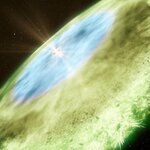Space

A team of astrophysicists using results based upon observations of 10 quasars say they have discovered the extent to which quasars and their black holes can influence their galaxies.
The researchers documented the immense power of quasar radiation, reaching out for many thousands of light years to the limits of the quasar's galaxy. The radiation released by a quasar covers the entire electromagnetic spectrum, from radio waves and microwaves at the low-frequency end through infrared, ultraviolet, and X-rays, to high-frequency gamma rays.
A central black hole, also called an active…

A new study by astronomers using the Atacama Large Millimeter/submillimeter Array (ALMA) telescope have discovered columns of cold, dense gas exiting the disk of nearby starburst galaxy NGC 253, also known as the Silver Dollar Galaxy.
NGC 253 is located 11.5 million light-years away in the constellation Sculptor. The galaxy, with its slightly askew orientation, offers astronomers an uncommonly clear view of several super star clusters near its center. These clusters denote areas where new stars are forming and they also mark the starting point for material being ejected from the galaxy…

It would be great to study Mars "on location". You could do as much in a day or two, as our rovers could do in years. But there's a conundrum to face. Humans are host to hundreds of trillions of micro-organisms, and we can't be sterilized like a rover; we would die. Can humans explore Mars without introducing Earth life?
What makes Mars so special?
Mars is the planet in our solar system most similar to Earth. It probably had oceans early on, like Earth. Sadly we know almost nothing about the very beginnings of life on Earth.
The simplest independently living micro-organisms we know of are…

There are valley networks branching across the Martian surface, which makes it reasonable to believe that water once flowed on the Red Planet.
Where water might have come from would be another mystery. Whether it bubbled up from underground or fell as rain or snow is the subject of speculation and debate but a new study says it can put a new check mark in the 'precipitation' column. The authors say that water-carved valleys at four different locations on Mars appear to have been caused by runoff from orographic precipitation — snow or rain that falls when moist prevailing winds are…

On July 18th, 2013, at 9:06 a.m. EDT, the Solar and Heliospheric Observatory (SOHO) captured an image of a gigantic coronal hole hovering over the sun's north pole.
Coronal holes are dark, low density regions of the sun's outermost atmosphere, the corona, and contain little solar material and lower temperatures so they appear much darker than their surroundings.
Coronal holes appear at different places and with more frequency at different times of the sun's activity cycle, which is currently ramping up toward what is known as solar maximum, currently predicted for late 2013. During this…

The orbital motion of two distinct populations of stars in an ancient globular star cluster, 47 Tucanae, have offered proof they formed at different times and it provides a rare look back into the Milky Way galaxy's early days.
The researchers combined recent Hubble observations with eight years' worth of data from the telescope's archive to determine the motions of the stars in 47 Tucanae, located about 16,700 light-years away in the southern constellation Tucana. The analysis enabled researchers, for the first time, to link the movement of stars in the clusters with the stars' ages. The two…

The Atacama Large Millimeter/submillimeter Array (ALMA) has captured the first ever image of the snow line in an infant solar system.
Say what?
On our planet, snow lines form at high altitudes where falling temperatures turn the moisture in the air into snow. This line is clearly visible on a mountain, where the snow-capped summit ends and the rocky face begins. The snow lines around young stars form in a similar way, in the distant, colder reaches of the dusty discs from which solar systems form.
Starting from the star and moving outwards, water (H2O) is the first to freeze, forming the…

Why do we value gold? It's not strong, it's not pretty, it's rare but in the 21st century, given enough energy we can turn lead into gold, the way alchemists once only dreamed about.
It's not just rare on Earth, it's rare in the universe, even though the universe has a fantastic amount of energy, it is a perpetual Philosopher's Stone. Yet even in the infinite universe creating gold is not trivial. Unlike elements such as carbon or iron, gold cannot be created within a star. Instead, it must be born in a more cataclysmic event, like one that was witnessed last month: a short gamma-ray burst…

On July 16th, 2013, at 12:09 a.m. EDT, the sun erupted with an Earth-directed coronal mass ejection, sending billions of tons of particles into space. These particles cannot travel through the atmosphere to harm humans on Earth, but they can affect electronic systems in satellites and on the ground. The particles will reach Earth over the next few days.
Experimental NASA research models, based on observations from NASA's Solar Terrestrial Relations Observatory, show that the CME left the sun at speeds of around 560 miles per second, a fairly typical speed.
Earth-directed CMEs…

In 2011 the Very Large Telescope (VLT) discovered a gas cloud with several times the mass of the Earth accelerating towards the black hole at the center of the Milky Way. The cloud is now so stretched that its front part has passed the closest point and is traveling away from the black hole at more than 10 million km/h, whilst the tail is still falling towards it.
The black hole at the center of the Milky Way, known as Sgr A* (pronounced Sagittarius A star), is estimated to have a mass of about four million times that of the Sun and is the closest supermassive black hole known - so it…